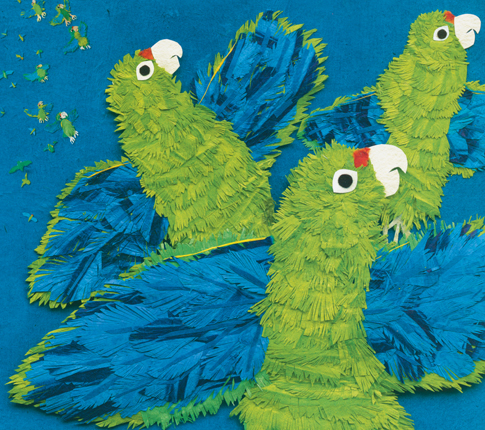Full Text Reviews: School Library Journal - 10/01/2013 Gr 3–6—Before humans arrived on the island, parrots numbered in the hundred of thousands. By 1967, only 24 birds remained. Since then, scientists in the Puerto Rican Parrot Recovery Program (PRPRP) have established aviaries to raise the birds in captivity and release them in the wild. Using a vertical page orientation, Roth has plenty of space for detailed collages that depict the parrots' lives and struggles above human activities that have altered the island's ecosystem over the centuries. Taínos, Spanish explorers and settlers, African slaves, and others hunted parrots for food, cut down nesting places, and introduced animals that ate their eggs. After the United States took control, deforestation continued. Some military history and political questions such as the debate about Puerto Rico's commonwealth status slow the narrative. When the focus shifts to the strategies, setbacks, and successes of the PRPRP, the story soars. From constructing nesting boxes to training captive-bred birds how to avoid hawks, the program is slowly rebuilding the parrot population. After the main story, several pages of photos accompany further explanations of the group's work. In addition to their list of sources, the authors supply a detailed time line of events. Like this team's The Mangrove Tree (Lee & Low, 2011), this title offers an engaging and hopeful look at environmental restoration.—Kathy Piehl, Minnesota State University, Mankato - Copyright 2013 Publishers Weekly, Library Journal and/or School Library Journal used with permission. Booklist - 11/15/2013 *Starred Review* Few nonfiction picture books attempt this level of ambition, and even fewer succeed. Thankfully, Roth and Trumbore’s first instinct ends up being the best one: To tell the story of the Puerto Rican parrot you must also tell the story of Puerto Ricans. The earliest human inhabitant of the island originally known as Boriquén arrived by boat around 5,000 BCE. They found a land replete with wildlife, including the brightly colored parrots that built nests in the trees. Watershed moments in Puerto Rican history—including first contact with Europeans in 1493, the arrival of slaves from Africa, and the Spanish-American War—parallel the sharp decline in the parrots’ population, which numbered only 24 by the 1960s. That’s when collaborative efforts of the Puerto Rican and American governments to protect the parrots began, as scientists taught the birds basic social behaviors, how to recognize enemies, and how to raise their young. Roth’s stunning artwork—fluttery, textural collages of fabric and paper with a three-dimensional quality—complement the high-interest narrative and are arranged vertically across dual pages to make the most of the tall trees and the related human actions taking place below. A triumphant reminder of the inescapable connection between people’s actions and the animals in the wild. - Copyright 2013 Booklist. Bulletin for the Center... - 01/01/2014 In this cross-disciplinary picture book, Roth and Trumbore trace the history of the Puerto Rican parrot, the only parrot indigenous to the United States and its territories, linking the bird to the history of the island itself. The book examines the ways humans have affected the environment for the parrot, from the early Taíno people to European settlers to the current populace. The parrot nearly became extinct by the mid-twentieth century due to habitat destruction and competition from invasive species and both historical and contemporary efforts to protect the parrot are described. The book is notable for its parallel treatment of both social and ecological histories, offered in engaging and descriptive prose-hardly a page goes by without the refrain of the parrots’ call (Iguaca!). The paper and fabric collage illustrations are lush with texture, using fine detail to show off the verdant landscape and dramatic unfolding of events; the book’s vertical format highlights the flight of the birds over Puerto Rico, with visual depictions of the parrots and their lives displayed above text about the island’s development and colonization. This can certainly serve as a crossover between social studies and science classrooms, but the story’s vivid enough to stand on its own as a grand environmental narrative. An afterword includes photographs and additional information about conservation efforts, while additional back matter includes a timeline and bibliography. TA - Copyright 2014 The Board of Trustees of the University of Illinois. Loading...
|



